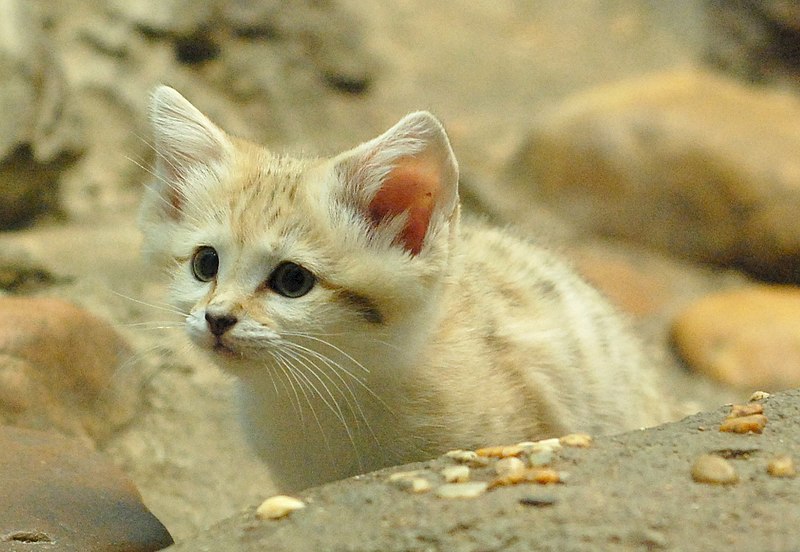
Posted on 08/10/2011 7:41:59 PM PDT by LucyT
There's hope for the Israeli sand cat species as one named Rotem gave birth to a girl kitten, Renana (meaning "joy" or "song"), three weeks ago at the Ramata Gan Safari outside of Tel Aviv.
Solitary felines that once freely roamed the sand dunes of Israel, the sand cats are now largely thought to be extinct outside of captivity in that area of the world.
[snip]
Zookeepers are hoping to enter Renana into Israel's Sand Cat Breeding Program, whose mission is to reintroduce sand cats back to their native, natural habitat
Adorable photo of Sand Cat at link.
(Excerpt) Read more at blog.zap2it.com ...
The Sand Cat (Felis margarita), also referred to as the "sand dune cat", is a small wild cat distributed over African and Asian deserts. (The name "desert cat" is reserved for Felis silvestris lybica, the African wildcat.) The Sand cat lives in arid areas that are too hot and dry even for the African Wildcat: the Sahara, the Arabian Desert, and the deserts of Iran and Pakistan.
Victor Loche was the first European to describe the sand cat for science (in 1858). He named the species Felis margarita after Jean Auguste Margueritte, the leader of the expedition during which he had encountered the animal.
The sand cat is a relatively small, stocky cat with short legs, a long tail, and large, pointed ears. They range from 39 to 57 centimetres (15 to 22 in) in length, plus a 23 to 31 centimetres (9.1 to 12 in) tail, and weigh from 1.4 to 3.4 kilograms (3.1 to 7.5 lb).[3] The head is conspicuously broad, and the ears are so widely spaced that they can be flattened horizontally, or even pointed down to aid in hunting.
The color of the fur is a pale sandy yellow over most of the body, with pallid bars which are sometimes hardly visible, and is white on the chin and underside. Generally the bars are more visible in the African subspecies. There are black bands on the legs and tail, and reddish lines running across the cheeks from the outer corners of the eyes. In winter, the coat can be very thick, with the hairs reaching up to 2 inches (5.1 cm) in length. The eyes are large and greenish yellow in color, while the nose is black.
Unusually among Asian cats, the sand cat has long hairs growing between its toes. These create a cushion of fur over the foot pads, helping to insulate them while moving over hot sand. The claws on the hind feet are small and blunt; combined with the fur over the foot pads, this helps to make the animal's tracks obscure and difficult to follow.
[snip]
As their name implies, sand cats live only in areas of dry, sandy desert. They prefer flat or undulating terrain with sparse vegetation, avoiding bare sand dunes, where there is relatively little food. They can survive in temperatures ranging from −5 °C (23 °F) to 52 °C (126 °F)[citation needed], retreating into burrows during extreme conditions. Although they will drink when water is available, they are able to survive for months on the water in their food.
Little is known about the Sand cat's life expectancy in the wild, but it can live up to 13 years in captivity.
Hunting this cat is prohibited in Algeria, Iran, Israel, Kazakhstan, Mauritania, Niger, Pakistan and Tunisia. No legal protection is offered by Egypt, Mali, Morocco, Oman, Saudi Arabia, or United Arab Emirates.
Read more, and see photos at:
http://en.wikipedia.org/wiki/Sand_Cat
The sand cats scare easily. But they’ll be back. And in greater numbers.
.
Kitteh Ping.
.
They have been observed to travel from 5 to 10 kilometres (3.1 to 6.2 mi) per night in search of prey, but, unlike most other cats, do not defend their territories, and may even "take turns" over burrows.
The only thing I can say is "Last cat out, cover up the hole".



Ooooh, I want one!
Awww, thanks nully.

Shrek Kitteh:

:)

Much cuter than a Viking Kitty :)
“And what about my ears?”

Oooh, not so cute!
That be one cool looking pussy cat? Can we make ‘em grow larger. Can they be taught to attack towelheads?

Don't worry. Not you.
Disclaimer: Opinions posted on Free Republic are those of the individual posters and do not necessarily represent the opinion of Free Republic or its management. All materials posted herein are protected by copyright law and the exemption for fair use of copyrighted works.